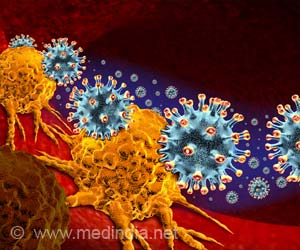Tiny, solitary spikes that stick out of nearly every cell in the body play a central role in a type of skin cancer, new research has found.
New research has revealed that tiny, solitary spikes that stick out of nearly every cell in the body play a central role in a type of skin cancer. The discovery in mice shows that the microscopic structures known as primary cilia can either suppress or promote this skin cancer, depending on the mutation triggering the disease.
The finding suggests that drugs that boost or block primary cilia activity could offer a new strategy against cancer. Unlike the more familiar motile cilia, primary cilia do not move, and only one pokes out of each cell. They have recently been discovered to play an essential role in assuring normal embryological development. The new study focused on basal cell carcinoma, the most common cancer in the United States.It is published in the August 23, 2009 advanced online issue of "Nature Medicine." A companion article in the same issue reports a similar discovery regarding a type of brain tumor in children known as medulloblastoma. (See related UCSF news release on this finding.)The two studies were led by scientists at the University of California, San Francisco, and they are the first demonstrations that primary cilia are required for some kinds of cancer. They are also the first reports that these cilia can protrude from cancer cells, as they do from most normal cells.
If the basal cell carcinoma finding is confirmed in people, the discovery raises the possibility of new cancer treatment strategies, said Jeremy Reiter, MD, PhD, senior author of that paper. Reiter is assistant professor of biochemistry and biophysics, an investigator at the Cardiovascular Research Institute, the Diabetes Center and the Eli and Edythe Broad Center of Regeneration Medicine and Stem Cell Research at UCSF. In July, President Obama named him as a recipient of the Presidential Early Career Award for Scientists and Engineers for his research on the links between cilia and cancer.
Although they are relegated to the outskirts of the cell, primary cilia help determine which genes are turned on in the nucleus. Two cilia proteins, called Smoothened and Gli, are pivotal in this process. When mutated, they can trigger basal cell carcinoma and other cancers. Clinical trials are already underway to treat cancer with drugs that block the activity of one of these rogue proteins.
"Attacking cilia directly could provide an effective complementary treatment for some cancers," Reiter said, noting that nearly all cancer treatments combine several approaches to kill tumors. In addition, primary cilia could serve as indicators of the specific mutation causing a cancer, and also help identify how aggressive a tumor is – both useful diagnostics to direct treatment, Reiter said.
The experiments in Reiter's lab drew on discoveries that solitary cilia help choreograph the steps needed to shape the developing embryo. A much-studied signaling molecule called Sonic Hedgehog cruises between cells to direct their behavior, and carries instructions to activate sets of genes at different stages of development. Its signal is also essential for normal cell growth.
Advertisement
The new research reveals that removing primary cilia from skin cancer cells blocks the mutated, hyper-active Smoothened from stimulating tumor growth. The study also found that removing primary cilia actually boosts tumor growth spurred by the other mutated protein, Gli.In other words, cilia promote cancer growth if Smoothened is hyper-active, but they suppress cancer if Gli is hyper-active.
Advertisement
"It does both -- providing both an accelerator and a brake for tumor growth. If cancer is a run-away car, some mutations cause cancer by opening up the throttle. Others promote cancer by cutting the brake line. The cilium houses both the gas and brake pedals for Hedgehog signaling. "Targeting primary cilia with drugs may neutralize the effect of these mutations – either by boosting cilia function when Gli is hyper-active, or inactivating cilia when mutated Smoothened poses a threat, Reiter said.
"Understanding the molecular machinery that goes awry in cancer should help scientists design new drugs to specifically block the effects of that broken machinery," Reiter said.Reiter's team studied each of the two over-active, tumor-inducing mutant proteins in the skin of mice. As expected, the mutated proteins promoted tumor growth similar to human basal cell carcinoma.
They then removed the cilia in those cells to reveal the effect on tumor growth. Primary cilia are normally disassembled before each cell division, and then the daughter cells reconstitute them. Since cancer disrupts normal cell growth, many scientists had thought that cancer cells might not have cilia at all. "The role that cilia play in some cancers gives us another target for anti-cancer therapies," Reiter said.
Source-Eurekalert
TAN















